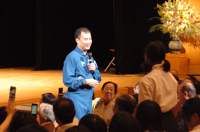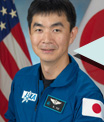JAXA Astronaut Activity Report, September 2010
Last Updated: November 12, 2010
This is JAXA's Japanese astronaut primary activity report for September 2010.
Astronaut Candidate Training
JAXA’s astronaut candidates Yui, Onishi, and Kanai continued their Astronaut Candidate (ASCAN) training at NASA’s Johnson Space Center (JSC) and other related training sites in the US.
Their training this month centered on systems of the International Space Station (ISS) and Extravehicular Activities (EVA). They also continued their language lessons and flight training aboard a T-38 jet trainer.
In the training on the ISS systems, Yui learned emergency procedures to respond to sudden depressurization and air contamination aboard the ISS. He also learned how to prepare meals/drinks and how to use the toilets on board the ISS. In the EVA training using the Neutral Buoyancy Laboratory (NBL) at JSC, Yui learned how to accomplish spacewalk tasks while focusing on safety and efficiency. He successfully completed the EVA portion of the ASCAN training in September 2010.
Onishi’s flight training aboard a T-38 jet trainer this month focused on troubleshooting system anomalies and unexpected weather changes. He learned how to assess exact situations and how to decide on actions required to handle the situations in tandem with a partner in the pilot seat.
Kanai learned the station’s Environment Control & Life Support System (ECLSS), Water Recovery System (WRS), and attitude control system. He also learned how to resolve anomalies related to the Electrical Power System (EPS) and air leakage. During the EVA training, he donned an Extravehicular Mobility Unit (EMU) suit and simulated EVA tasks in the NBL pool. He learned how to operate equipment of the ISS Quest Airlock.

NOLS Training (Photo Credit: JAXA/NASA)
The three candidates participated in the National Outdoor Leadership School (NOLS) held in Utah along with the other ASCAN trainees. The NOLS training camp is designed to develop self-management skills, good teamwork with balanced leadership and followership, and the judgment to choose an appropriate response to unexpected events or critical situations. During the training, every trainee took the role of leader in turn, and went through the camp cooperating with the other trainees.
Between training sessions, Yui and Onishi visited NASA’s Glenn Research Center (GRC) and the Canadian Space Agency (CSA), as part of their on-site facility orientation. They learned the overview of the centers’ major programs and activities.
Astronaut Furukawa Trains for ISS Expedition Mission
Astronaut Furukawa, assigned as an ISS Expedition 28/29 crew member, participated in operation training held at JAXA’s Tsukuba Space Center (TKSC) on Kibo, JAXA’s new science experiments, and the H-II Transfer Vehicle (HTV).

Astronaut Furukawa (front) and NASA astronaut Catherine Coleman (back) during operations training on the JEMRMS (Photo Credit: JAXA)
During the Kibo operations training, Furukawa participated in a joint simulation with the JAXA Flight Control Team (JFCT) and simulated robotic transfer of an exposed payload using Kibo’s robotic arm, the JEM Remote Manipulator System (JEMRMS). Furukawa also reviewed procedures to install and relocate the racks on board Kibo, as well as maintenance procedures of the onboard equipment.
During the training related to JAXA’s new science experiments, Furukawa learned the overview of the Gradient Heating Furnace (GHF), JAXA’s new science rack to be installed in Kibo. He also received a lecture on the Hicari experiment (Growth of Homogeneous SiGe Crystals in Microgravity by the TLZ Method) from the experiment’s Principle Investigator (PI), Kyoichi Kinoshita, Institute of Space and Astronautical Science, JAXA (ISAS JAXA). The experiment will be performed on orbit using the GHF. The training session on Kibo science operations was open to the media. Using the GHF mockup, Furukawa reviewed the procedures to exchange a sample cartridge of the GHF rack. The procedures will be performed manually by an ISS crew member on orbit. In addition, Furukawa reviewed how to set up and activate the GHF.
During the HTV operations training, Furukawa reviewed cargo transfer between the HTV and ISS, as well as emergency procedures to respond to fire, sudden depressurization, air contamination, electrical leakage, and other anomalies on board the HTV Pressurized Logistics Carrier (HTV-PLC).
After completing the training at TKSC, Furukawa returned to JSC and practiced grappling/berthing of the HTV using the Space Station Remote Manipulator System (SSRMS) simulator with NASA astronaut Michael Fossum, who will be Furukawa’s crew mate on the Expedition 28/29 mission. While Fossum was simulating SSRMS manipulation, Furukawa helped Fossum grapple the HTV by adjusting the angle of external cameras and checking the operational procedures.
Furukawa then practiced in-flight medical operations using a training model of the Ultrasound System, which is installed in the Human Research Facility (HRF) rack on board the ISS. He also used the Virtual Reality System to simulate EVA activities.

Furukawa (back) and Fossum (front) monitoring the clearance/position of the HTV on a robotic workstation simulator while simulating the SSRMS’s grapple operations (Photo Credit: JAXA/NASA)

Furukawa practicing in-flight medical operations using the Ultrasound System (Photo Credit: JAXA/NASA)

Furukawa using the VR system to simulate EVA tasks (Photo Credit: JAXA/NASA)
Public Mission Debriefing by ISS Expedition 22/23 Crew

Astronaut Noguchi answering questions from the audience at a public event in the town of Taishi, Hyogo Prefecture (Photo Credit: JAXA)
Astronaut Noguchi, alongside his US and Russian expedition crew mates, participated in a public mission debriefing in Kyoto (Kyoto Prefecture).
At the public mission debriefing in Kyoto, Noguchi talked about the mission activities on board the ISS, such as arrival of the Russian Progress, tasks of the Russian EVAs, and the science operations and routine checkout/maintenance he engaged in on orbit. Following the mission debriefing session, a panel discussion took place, during which the Unit of Synergetic Studies for Space from Kyoto University presented their current efforts in Japan’s future space exploration. There was also a wider-range debate on what approach and action should be prepared and taken for future space explorations from the standpoint of the arts and social sciences.
Noguchi participated separately in lectures in Kobe (Hyogo Pref.) and in Taishi (Hyogo Pref.). During the lectures, he spoke about his mission aboard the ISS while showing photos and video of the mission.







